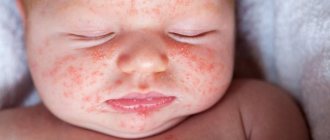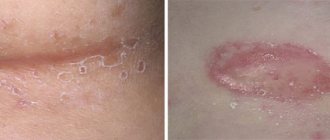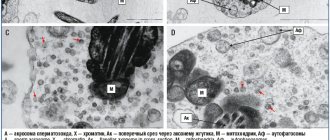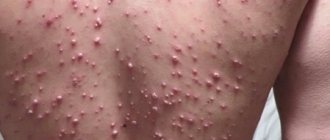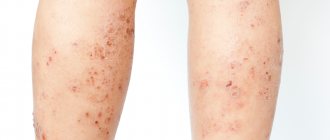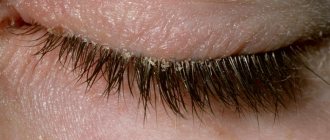Herpes in a child is essentially a chronic recurrent infection caused by virions of the herpes simplex virus (HSV). The virus primarily affects integumentary tissues and nerve ganglia (cells).
The main route of infection is contact, the release of the virus onto the damaged surface of the skin and mucous tissues. In addition to the main route, the virus can be transmitted through airborne dust and droplets, and transmitted transplacentally and intrapartum (from mother to child). Viruses that have entered the body are able to remain in an inert state for a long time in nerve cells and “awaken” during a period of weakening of the immune defense, provoking an infectious relapse.
Primary herpes in a child on the face and other areas often has a latent course. The disease appears later. The acute form of infection is diagnosed in only 20% of children infected with the virus. At the same time, to draw up an intensive care plan, it is important to know what type of virus caused the infection.
Classification
Herpes infection is classified according to the signs of predominant tissue damage, the nature of the disease and the type of rash.
There are 8 types of herpesvirus that affect children, but 7 and 8 have not been studied enough:
| Type | Features of manifestation |
| HSV type 1 (herpes labialis) | Herpes manifests itself on the lips of a child in the form of blistering rashes. May provoke the development of herpetic stomatitis and encephalitis. |
| Type 2 | It affects the genitals with a rash (genital herpes). |
| Type 3 | The causative agent of chickenpox and recurrent herpes zoster. |
| Type 4 (Epstein-Barr virus) | Causes the development of malignant lymphoma and infectious mononucleosis - an acute viral pathology accompanied by fever, damage to the respiratory system, spleen, liver, lymph nodes and blood. |
| Type 5 (cetomegalovirus) | Affects the respiratory, nervous and urinary systems, intestines, brain and eyes. |
| Type 6 | It mainly affects young children, manifesting itself as a viral exanthema - a rash similar to rubella. |
According to the development of the disease, herpes is divided into: acquired, primary, recurrent and congenital.
According to the form of infectious prevalence, 4 stages of development are distinguished:
- latent - carriage without the manifestation of specific symptoms;
- localized - with a single lesion;
- widespread – with the presence of 2 or more lesions;
- generalized - disseminated and visceral (spreading to internal organs).
Epstein-Barr virus infection
An infectious disease caused by the Epstein-Barr virus (EBV) and characterized by a systemic lymphoproliferative process with a benign or malignant course.
EBV is isolated from the body of a patient or virus carrier with oropharyngeal secretions. Transmission of the infection occurs through airborne droplets through saliva, often when a mother kisses her child, which is why EBV infection is sometimes called the “kissing disease.” Children often become infected with EBV through toys contaminated with the saliva of a sick child or a virus carrier, when using shared utensils and linen. Blood transfusion and sexual transmission of the infection are possible. Cases of vertical transmission of EBV from mother to fetus have been described, suggesting that the virus may be the cause of intrauterine developmental anomalies. Contagiousness during EBV infection is moderate, which is probably due to the low concentration of the virus in saliva. The activation of infection is influenced by factors that reduce general and local immunity. The causative agent of EBV infection has a tropism for the lymphoid-reticular system. The virus penetrates the B-lymphoid tissues of the oropharynx and then spreads throughout the body's lymphatic system. Infection of circulating B lymphocytes occurs. The DNA virus penetrates into the nuclei of cells, while the proteins of the virus give infected B-lymphocytes the ability to continuously multiply, causing the so-called “immortality” of B-lymphocytes. This process is a characteristic feature of all forms of EBV infection.
EBV can cause: infectious mononucleosis, Burkitt's lymphoma, nasopharyngeal carcinoma, chronic active EBV infection, leiomyosarcoma, lymphoid interstitial pneumonia, hairy leukoplakia, non-Hodgkin's lymphoma, congenital EBV infection.
Reasons for the development of the disease
GVI can occur in children of any age. Only those babies whose mothers had herpes before the second trimester of pregnancy have immune protection against the virus. At six months of age, protective maternal antibodies to the virus disappear, which increases the risk of developing a primary infection caused by herpes virions.
Basically, the infection manifests itself as herpes on the child's lip, causing pain and discomfort. In almost every child, after 4 years, the first type of virus can appear regularly, signaling a weak immune system. Many factors can provoke herpes in a child:
- heat;
- cold infections;
- exacerbation of chronic pathologies;
- skin wounds;
- stress conditions and hypovitaminosis;
- active sunlight;
- hypothermia;
- excessive dryness of the mucous membranes.
When to see a doctor
With a primary infection, the child almost always develops a fever. The baby has no appetite, anxiety, crying, and sleep disturbances. If one of the above symptoms is present or if there are several of them, you need to immediately show the newborn to a specialist - a pediatrician (children's doctor) or a dermatovenerologist.
If the infection develops, it can lead to complications, including death. The herpes virus in newborns should be identified as quickly as possible so that treatment can begin without delay. If there are signs of herpes in an infant, you can visit JSC “Medicine” (academician Roitberg’s clinic) in the center of Moscow. The Pediatrics Department has a staff of highly qualified specialists, new generation equipment and instruments for examination. You can make an appointment with a pediatrician or dermatovenerologist on the website or by calling +7(495)993-00-33.
Symptoms and clinical signs
The clinical picture of the disease and symptoms depend on the location of the herpes virus.
- When the skin is affected, the process is usually localized in the area of the lips and wings of the nose, manifested by subjective sensations of itching and burning. Soon the affected area thickens, vesicles (bubbles) appear, filled with gradually cloudy exudate. After opening the bubbles, small pockets of erosion remain, covered with a crust.
Healing leaves no traces. Quite often, children tear off scabs prematurely - this is a direct path for a bacterial pathogen and the development of suppurative processes. The clinical picture of the disease may be accompanied by enlargement and pain of regional lymph nodes. Additional symptoms can be observed only against the background of concomitant diseases.
- Herpes on the oral mucosa provokes acute or recurrent stomatitis, accompanied by general signs of intoxication and fever.
Groups of small blistering rashes form on the oral mucosa. After opening them, painful erosions that do not heal for a long time (up to 2 weeks) remain. Sometimes the consequences of GI manifest themselves as aphthous stomatitis with the formation of single, very painful aphthae that form ulcers. This form of infection is characterized by a tendency to relapse.
- The clinic of herpetic lesions of the type of acute RVI proceeds without rashes. Sometimes the blistering rash affects the tonsils and the back of the throat.
- Manifestations of ophthalmoherpes are characterized by vesicular lesions of the cornea followed by the formation of ulcers, which reduces its sensitivity and causes visual impairment. A recurrent process can cause persistent clouding of the cornea and lead to blindness.
- When the nervous system is damaged, the clinical picture of the disease is manifested by severe intoxication, high fever, convulsive symptoms, paresis or persistent paralysis, and loss of consciousness may be observed.
- Signs of herpes zoster are manifested by general malaise, headaches, dyspeptic and intoxication symptoms, itching and burning in the projection of nerve branches. In the area of the vesicles, intense paroxysmal pain and burning are noted. Sensitivity disturbances in the area of innervation of the affected nerve, paresis of the vesical sphincter, muscles of the peritoneal wall and limbs, facial and oculomotor nerves may occur.
In newborns and children with severe immune deficiency, generalized forms of HI may develop with signs of extensive damage to the skin, mucous tissues and internal organs with signs of intoxication and high fever.
Clinical manifestations
Stomatitis in children is characterized by a gradual onset of the disease. Clinical signs of the disease do not appear immediately after infection. The incubation period is typical for this pathology; it lasts from two days to three weeks.
Symptoms of herpetic stomatitis in children appear starting from the prodromal period.
Each period has its own clinic:
- Latent – lasts up to two weeks. The child's sleep is disturbed and he refuses to eat. The baby becomes restless and whiny. He has increased salivation, possible nausea and vomiting. The lymph nodes are enlarged and painful on palpation.
- The height of the disease - at this time rashes appear on the skin and mucous membranes. They are located on the soft, hard palate, gums, cheeks, lips and tongue. They are group or single, up to three millimeters in size. They are thin-walled bubbles filled with a clear liquid. Their formation lasts up to four days. The vesicles quickly open, then erosions and painful aphthae form. They are shallow ulcers covered with a white coating. The mucous membrane in the mouth is swollen and bleeding. The child develops a high temperature of up to 40 degrees. A runny nose, cough, and conjunctivitis occur.
- Fading - aphthae, erosions gradually heal and epithelialize. These formations heal without scarring. Often there is a wavy course of the disease. The periods of appearance of rashes alternate with rises in temperature.
The illness usually lasts up to two weeks. In children under one year of age, generalization of the process is possible. The development of sepsis, damage to all internal organs and meninges is likely.
Methods for diagnosing and treating herpes in a child
Despite the rather typical symptoms, a standard package of studies is provided to confirm the diagnosis, including:
- laboratory blood tests - general and biochemical tests;
- ELISA (enzyme-linked immunosorbent assay) to detect antibodies;
- study of biomaterial (cerebrospinal fluid, blood, vesicular exudate) using the PCR method, which makes it possible to detect and identify the virus at any stage of infection, even if there are no antibodies in the blood yet.
Treatment tactics are selected taking into account the individual characteristics of the child, the type of pathogen identified and the severity of clinical manifestations. There is no specific treatment for herpes. Once it enters the body, it remains there for life. Treatment of the disease is symptomatic, aimed at alleviating the child’s condition, preventing the spread of infection and its generalization. Treatment includes appointments:
- antiviral drugs that help stop the infectious process;
- drugs for symptomatic therapy - antipyretic, analgesic, antipruritic and decongestant;
- topical antiseptics - solutions, ointments, gels that can relieve pain and itching;
- preparations for treating affected mucous tissues;
- physiotherapy sessions (EHF, magnetotherapy, ultraviolet irradiation, infrared irradiation).
Cytomegalovirus infection
An infectious disease that is caused by cytomegalovirus (CMV) and is characterized by a variety of clinical forms (from asymptomatic to severe generalized with damage to many organs) and course (acute or chronic). CMV transmission factors can be almost all biological substrates and human secretions that contain the virus: blood, saliva, urine, cerebrospinal fluid, vaginal secretions, sperm, amniotic fluid, breast milk. Potential sources of infection are organs and tissues in transplantology, as well as blood and its products in transfusiology. Routes of transmission of CMV infection: airborne, sexual, vertical and parenteral.
There are congenital and acquired forms of CMV infection. Congenital CMV infection. During antenatal infection of the fetus, infection occurs predominantly transplacentally. During intrapartum infection, CMV enters the body through aspiration of infected amniotic fluid or secretions from the mother's birth canal.
In older children, acquired CMV infection occurs in a subclinical form in 99% of cases. The most common manifestation of this form of CMV infection in children over one year of age is mononucleosis-like syndrome. As a rule, a clinical picture of acute respiratory disease is observed in the form of pharyngitis, laryngitis, and bronchitis.
Infections caused by the sixth, seventh and eighth types of herpes viruses Type six herpes viruses (HHV-6) can cause erythematous and roseolous rashes (sudden exanthema), lesions of the central nervous system and bone marrow in immunocompromised children. Herpesvirus type seven (HHV-7) causes neonatal exanthema
For the diagnosis of herpes infection, cytological, immunofluorescent, serological and PCR methods are valuable. Virological testing for herpes infection reveals complement-fixing antibodies to HSV-1 or -2 in the mother's blood, fetal cord blood and amniotic fluid. PCR method. The material for testing for herpes is blood, throat swabs, the contents of blisters, ulcers, and urine.
The study of specific antibodies of various subclasses: IgM, IgG1-2, IgG3 and IgG4 to herpes viruses is important. The detection in the blood serum of children of specific immunoglobulins M, IgG3, IgG1-2 in a titer > 1:20, viral antigen and specific immune complexes with antigen indicates the severity of the infectious process (active phase), and the determination of only specific IgG4 is regarded as the latent phase of infection or carriage of maternal antibodies.
Possible complications
In severe cases of the disease, complications may develop. When the facial and trigeminal nerves are damaged, severe pain and paralysis may occur.
When ophthalmoherpes is complicated, the child may develop inflammatory diseases of the cornea and develop retinal lesions.
In children with reduced immunity, damage to internal organs is possible. If the rash is localized in the perineum and tailbone, there is a risk of damage to the bladder and urination problems.
Infection of children
The content of the article
The child will not become infected in the first few months of life, because the innate immunity transmitted from the mother suppresses viruses. Infection can only occur if the mother does not have the virus and the child becomes infected from another person. Children usually get sick between the ages of 4 and 13 months. According to statistics, 90% of primary herpetic diseases occur before the age of 2 years.
Herpes virus type 6 can occur against the background of other diseases. Often its presence in the body depends on the presence of antibodies in the blood. Because of this, incorrect diagnoses are sometimes made.
Prevention
Following simple rules of prevention will help to significantly reduce the risk of a child becoming infected with herpes. Basic rules include:
- preventing child contact with sick children and adults;
- strict adherence to hygiene rules;
- balanced diet;
- immunostimulating therapy;
- specific vaccination.
In our multidisciplinary medical center, experienced doctors provide effective treatment for children with any manifestation of herpetic infection. Timely consultation with a doctor will help avoid the development of infection and dangerous complications.
Treatment
Herpetic infection occurs in 3 stages:
- Stage 1 – in the active stage or during exacerbation of the chronic course of the disease;
- Stage 2 – prolonged treatment with maintenance doses during the period of remission;
- Stage 3 – identification and sanitation of chronic foci of infection, examination of family members to identify the source of infection.
In all cases, drugs, their combination and duration are selected individually, taking into account the manifestations of the disease, the characteristics of the child’s immune system, age, and course of the disease.
Author of the material: pediatrician at the clinic on Rodionovskaya Telitsyna E.V.
